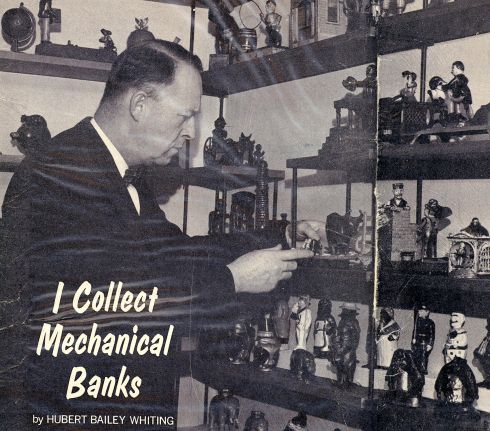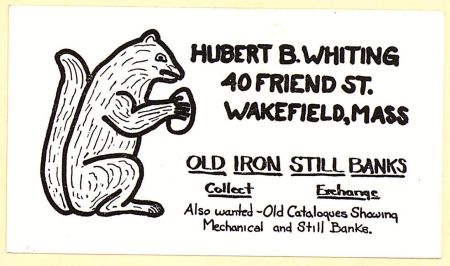|
YANKEE, May
1963


The author studies a new
purchase in his basement
hobby room at 40 Friend Street, Wakefield, Mass.
Don't
ever throw away a mechanical bank— there are some 1200 people in this
country who may want it!
● Several years ago while wandering along an old street in Baltimore,
Maryland, a small object in the window of an antique shop caught my eye. It
was an iron penny bank. In a flashback, I remembered as a small boy
receiving one just like it for Christmas. The appeal of that bit of
memorabilia was so strong that I purchased it immediately and it has become
the nucleus of a consuming hobby which has enriched my life. The collecting
of these beautiful old iron toys — mechanical and non-mechanical — which
taught thrift has given meaning and purpose to my leisure hours.
Now, a number of years later, that first little bank
has become one of several hundred and my hobby room has three walls lined
with shelves holding specimens of this early American art.
The quest for these banks has given me an opportunity
to enjoy the beauties of New England in the spring, the summer, and the
fall, for I have traveled it in those seasons from Rhode Island to Northern
Maine and west through New Hampshire and Vermont. Occasionally, I would find
a bank I especially wanted. What excitement it would create!! It might be a
tiny horse with a fly netting beautifully cast over its back, a cradle
holding a sleeping baby with a little bird perched on the headboard. There,
too, and your heart nearly stops beating, on a shelf would be a much-desired
mechanical bank. Where did they come from? What is the story behind them?
Sometimes the present owner would know. "It was my grandmother's;" or "It
belonged to my brother." "I acquired it when I cleaned out the attic of an
old house." Little mementos of early childhood, kept over the years from
sentiment or just from the New England habit of savings things.
Sometimes, a desired bank or two would be found in a
small collection being sold. However, to acquire the specimen of your
choice, the entire group must be purchased. With great trepidation I bought
such a collection and tried my hand at selling those banks which were
duplicates of mine. Through advertisements in magazines of interest to
antiquarians, inquiries came from fellow collectors in many parts of the
country, The most wonderful experience in selling came from setting up shop
in a "Flea Market" held in an open field in New Hampshire. This was not too
lucrative, but it was great fun.
There is a practical side to collecting which must be
considered seriously; collecting can be an expensive hobby. It is,
therefore, wise for a beginner to know the extent of his financial ability
to support such a hobby before a start is made.
"Mechanical" banks, for instance, vary in price from
twenty-five dollars to several thousand dollars each. "Still" banks
(non-mechanical) are priced from five dollars to fifty dollars each. From
this it can readily be seen that a bank collection of any appreciable size
has a very importunate monetary value.
Anyone interested in collecting as a hobby may find
reliable information in the many manuals written by various authorities on
antiques generally. These manuals, if used merely as guides, will help the
beginner in determining the condition of the item and whether the asking
price is fair or not. It is well, however, to bear in mind that prices
change with time and that experience with, and knowledge of, the subject are
invaluable assets in building a collection.
In "Banking" over the years, I have learned to identify
the smooth feel of old iron, to recognize the color and patina of old paint,
to look carefully for replaced parts, etc. Naturally, a bank in mint
condition (nearly perfect) has more value than one like it that has been
restored. It is necessary to watch, too, for reproductions, for there are
fine ones being made. All, however, are plainly marked, or should be.
Generally speaking, banks are not antiques since they
were made from the late nineteenth century, approximately 1910.
Perhaps the largest manufacturer of these toys was the
J & E Stevens Company, at Cromwell, Connecticut. This was due primarily to
the talents of Charles A. Bailey, the greatest and most outstanding of all
mechanical bank designers. This engineering artist worked closely with the
Stevens Company for many years. Mr. Bailey's banks are recognizable by the
intricate and beautiful use of flowers in the casting and the originality of
the pattern.
Banks are wonderful to collect — they must be since it
is thought that there are some twelve hundred collections scattered around
the country. It is an old hobby, which continues to attract new friends.
Some of the better known collections are held by large banking institutions.
"The Mechanical Bank Collectors of America," an
organization of sponsored members formed a number of years ago, accounts for
many more of the finest collections. This organization has a convention once
a year somewhere in the east, New York, New England or Pennsylvania. The
program, given over to speakers of unquestioned authority on the subject of
banks, is always informative and interesting. The group is very sociable,
too, for a mutual hobby makes warm friendships.
As the present secretary of the organization, I am in
contact with the other members throughout the entire year. This makes the
mail at 40 Friend Street, Wakefield, Massachusetts bulky and interesting.
Through this source, I have made many friends from New England to the
Pacific Coast. If a duplicate is found, the word is sent out to our hobby
friends, for we try to help each other in acquiring a desired specimen.
We're very competitive, too, which adds zest to the constant seeking.
Not long ago, I saw in a collection a small bank which
went straight to my heart. I wanted it in the worst possible way. However,
no amount of pleading or conniving or offers to trade persuaded its present
owner to part with it. He found it fascinating, also, you see! So I placed
it in the number one position on my desired list, kept my hopes high, and
let my friends take over.
On a quiet Sunday afternoon, a banker friend, literally
and figuratively speaking, came to spend an hour or two in my hobby room. We
talked, of course, about banks, exchanging experiences, discussing the
quality of the specimens in my collection, the number of years we had both
been collecting, etc. Of course, the story of my attempt to acquire the
little bank at the top of my list was sadly related. By way of contrast, I
told of a very desirable bank having been given to my wife, just because she
expressed a liking for it. What, I asked, had I done wrong? The stories were
received with a smile of genuine understanding. Just before leaving, my
guest drew from his pocket a carefully wrapped gift for me. What was it?
None other than the coveted bank on my special list. It had been acquired
many years ago by the donor and since it had no place in his present
collection, he was happy to transfer it to mine. It is only the second one
of its kind I have ever seen, and my pleasure in its ownership and my
gratitude to the donor is impossible to describe.
So now as I sit in my hobby room, the soft gleam of
light from my fireside shines on a red apple with a little bee resting on
its beautifully formed cheek; a very ferocious cat ready to spring on an
unsuspecting mouse; football players about to go into a huddle; a tiny
circus clown riding in his cart around a ring. Then, too, I see a sturdy
replica of "Oom Paul" (Paul Kruger, patriot of the Boer War) placidly
smoking his pipe; Little Red Riding Hood; Mutt and Jeff; the Bull and Bear;
not overlooking Independence Hall; Old South Church; Field House at West
Point; and so on and on.
These fine examples of careful, imaginative
craftsmanship seem to touch one's life at many points. They remind one of
early childhood, of history, of the beauties of nature, but most of all they
remind one to appreciate the skills, integrity and devotion to the
principles of industry and thrift of the people who preceded us in the
development of this great country. I have learned much from my hobby and we
are indeed close companions.

|